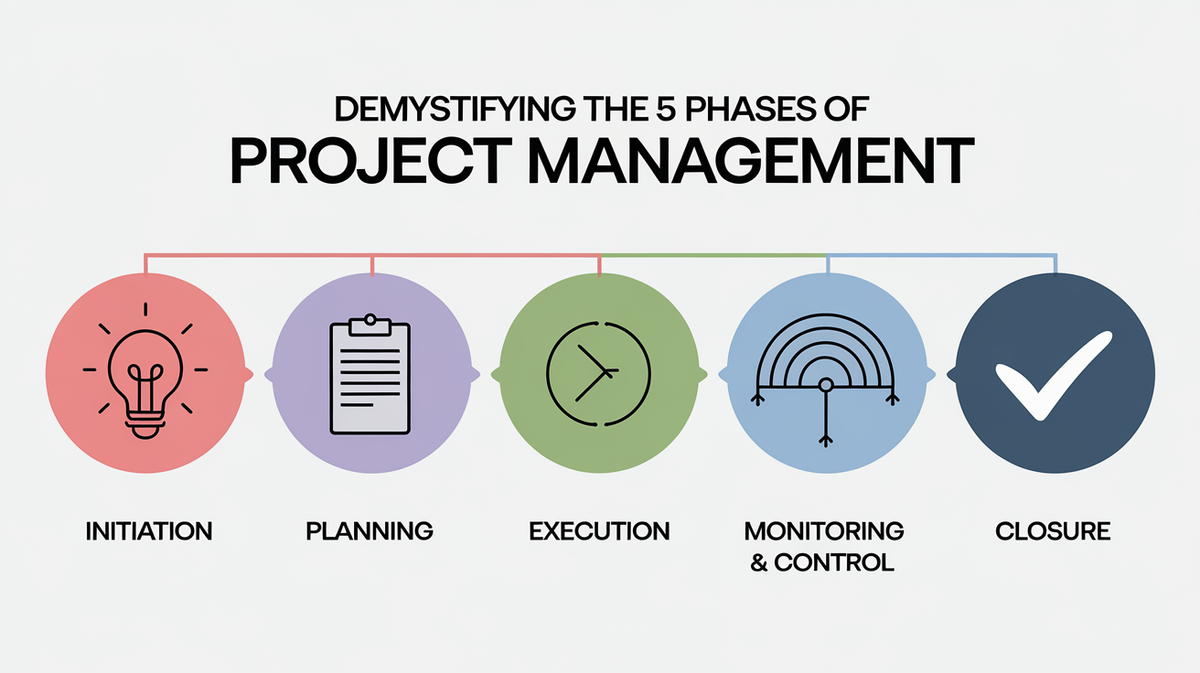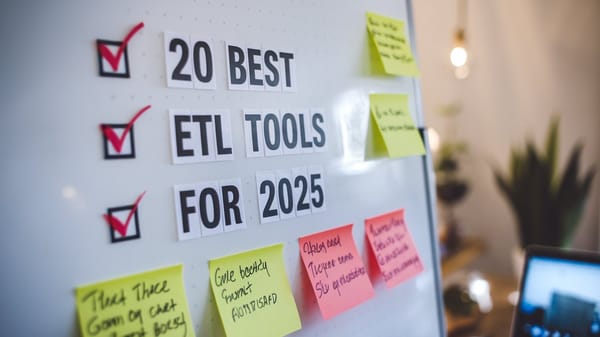Demystifying the 5 Phases of Project Management

In the realm of project management, understanding the project life cycle is crucial for ensuring successful project delivery. The concept of the project life cycle is a structured framework that guides project managers through the various stages of a project, from inception to completion. This framework is widely recognized and utilized across industries, providing a roadmap that helps project managers navigate the complexities of project execution.
It has formalized this framework into five distinct phases: initiation, planning, execution, monitoring and controlling, and closure. These phases are detailed in the PMI's Project Management Body of Knowledge (PMBOK), which serves as a comprehensive guide for project management professionals. The five-phase model is not only a standard in traditional project management but also adaptable to various methodologies, including agile frameworks like Scrum.
Each phase of the project life cycle addresses specific needs and objectives, ensuring that projects are systematically managed and delivered. The initiation phase involves defining the project's goals, scope, budget, and timeline, setting the foundation for the project's success. Planning follows, where a detailed action plan is developed to guide the project team. Execution is the phase where plans are put into action to deliver the project's objectives. Throughout the project, monitoring and controlling are essential to track progress and make necessary adjustments to stay on course. Finally, the closure phase wraps up the project, ensuring all deliverables are completed, and lessons learned are documented for future reference.
The importance of these phases cannot be overstated, as they provide a structured approach to managing resources, timelines, and deliverables. By breaking down a project into these manageable steps, project managers can better anticipate challenges and ensure that the project remains aligned with its goals. Moreover, utilizing the right project management tools can significantly enhance the efficiency and effectiveness of managing these phases.
You can also visit Oncely.com to find more Top Trending AI Tools. Oncely partners with software developers and companies to present exclusive deals on their products. One unique aspect of Oncely is its “Lifetime Access” feature, where customers can purchase a product once and gain ongoing access to it without any recurring fees. Oncely also provides a 60-day money-back guarantee on most purchases, allowing customers to try out the products and services risk-free.
Oncely are hunting for the most fantastic AI & Software lifetime deals like the ones below or their alternatives:

Table of Contents
- Understanding the Project Life Cycle
- Project Initiation
- Project Planning
- Project Execution
- Performance/Monitoring
- Project Closure
- Benefits of the Project Life Cycle
- Challenges in the Project Life Cycle
- Conclusion
- Detailed Explanation of the 5 Phases
- Initiating Process Group
- Planning Process Group
- Executing Process Group
- Monitoring and Controlling Process Group
- Closing Process Group
- Tools and Techniques for Effective Project Management
- Gantt Charts
- Kanban Boards
- Critical Path Method (CPM)
- Agile Methodology
- Risk Management Tools
- Resource Allocation Tools
- Communication Tools
- Quality Management Tools
- Change Management Techniques
- Conclusion
Understanding the Project Life Cycle
Project Initiation
The project initiation phase is the first step in the project life cycle, where the project's value and feasibility are measured. This phase involves creating a project charter or a business case to justify the project's necessity. The project charter outlines the project's objectives, scope, stakeholders, and high-level risks. It serves as a formal authorization for the project to proceed. During this phase, feasibility studies may be conducted to assess the project's viability. This phase is crucial as it sets the foundation for the entire project. According to the Project Management Institute (PMI), the initiation phase is where the project's purpose and requirements are defined, ensuring alignment with organizational goals.
Project Planning
Once the project is initiated, the planning phase begins. This phase involves developing a detailed project management plan that outlines the project's scope, schedule, cost, quality, resources, communication, risk, and procurement strategies. The project plan serves as a roadmap for the project team, guiding them through the execution phase. Key activities in this phase include defining project deliverables, creating a work breakdown structure (WBS), and developing a project schedule using tools like Gantt charts. The planning phase is critical for setting realistic timelines and budgets, as well as identifying potential risks and mitigation strategies. As noted by Smartsheet, effective planning ensures that the project team is well-prepared to execute the project successfully.
Project Execution
The execution phase is where the project plan is put into action. During this phase, project deliverables are developed and completed. The project manager's role is to coordinate resources, manage stakeholder expectations, and ensure that the project stays on track. This phase often involves managing teams, conducting status meetings, and communicating progress to stakeholders. According to Project-Management.com, the execution phase is where the majority of the project's budget is spent, and it requires effective leadership and communication to ensure that project objectives are met. Tools like Smartsheet and Asana can be used to track progress and manage tasks efficiently.
Performance/Monitoring
The performance or monitoring phase runs concurrently with the execution phase. It involves tracking the project's progress and performance against the project plan. Key performance indicators (KPIs) are used to measure project success, and any deviations from the plan are addressed through corrective actions. This phase ensures that the project remains aligned with its objectives and that any issues are identified and resolved promptly. As highlighted by Asana, monitoring is essential for maintaining control over the project and ensuring that it meets its goals. Regular status reports and performance reviews are conducted to keep stakeholders informed and engaged.
Project Closure
The final phase of the project life cycle is project closure. This phase involves completing all project activities, delivering the final product to the client, and obtaining formal acceptance. The project manager conducts a post-mortem analysis to evaluate the project's success and identify lessons learned. This phase also includes releasing project resources, archiving project documents, and closing out any contracts. According to Smartsheet, project closure is an opportunity to celebrate successes and reflect on areas for improvement. It ensures that all project objectives have been met and that the project is officially completed.
Benefits of the Project Life Cycle
The project life cycle provides a structured approach to project management, offering several benefits. It ensures that projects are delivered on time, within budget, and to the required quality standards. By dividing the project into distinct phases, the project team can focus on specific tasks and deliverables, reducing complexity and improving efficiency. The life cycle also facilitates better communication and collaboration among stakeholders, as each phase has clearly defined roles and responsibilities. As noted by Project-Management.com, the phased approach allows for regular reviews and adjustments, ensuring that the project remains aligned with its objectives and stakeholder expectations.
Challenges in the Project Life Cycle
Despite its benefits, the project life cycle also presents challenges. One common challenge is scope creep, where the project's scope expands beyond its original objectives, leading to increased costs and delays. Effective scope management and change control processes are essential to mitigate this risk. Another challenge is resource allocation, as projects often compete for limited resources. Project managers must prioritize tasks and allocate resources efficiently to avoid bottlenecks. Additionally, stakeholder management can be challenging, as different stakeholders may have conflicting interests and expectations. Clear communication and stakeholder engagement strategies are crucial for managing these challenges effectively.
Conclusion
The project life cycle is a fundamental concept in project management, providing a structured framework for delivering successful projects. By understanding and effectively managing each phase, project managers can ensure that projects are completed on time, within budget, and to the satisfaction of stakeholders. The life cycle approach not only enhances project outcomes but also contributes to the continuous improvement of project management practices. As organizations continue to face complex and dynamic project environments, the project life cycle remains an essential tool for achieving project success.
Detailed Explanation of the 5 Phases
Initiating Process Group
The Initiating Process Group marks the beginning of a project, where the groundwork is laid for all subsequent activities. This phase involves defining the project's high-level objectives, purpose, and scope. Key activities include the development of the project charter, which outlines the business need, high-level requirements, and overall vision for the project. The project manager is assigned during this phase, and stakeholders are identified (Project Management Process Groups: A Quick Guide).
The project charter serves as a formal authorization to proceed with the project, providing the project manager with the authority to apply organizational resources to project activities. This phase is crucial as it sets the direction and foundation for the project, ensuring alignment with organizational goals and stakeholder expectations (An Insider's Guide to the 5 Stages of Any Project).
Planning Process Group
The Planning Process Group is where the project plan is developed, detailing how the project will be executed, monitored, and controlled. This phase involves defining the project scope, objectives, and course of action required to achieve those objectives. It includes the development of the project management plan, which integrates subsidiary plans such as scope, schedule, cost, quality, resource, communication, risk, procurement, and stakeholder management plans (Why are project management process groups important?).
During this phase, project managers work closely with stakeholders to refine project objectives and develop a comprehensive plan that addresses potential risks and constraints. The planning phase is iterative, meaning it may be revisited as new information becomes available or as the project progresses (Understanding the Connections Across Process Groups).
Executing Process Group
The Executing Process Group involves coordinating people and resources to carry out the project management plan. This phase is where the actual work of the project is performed, and deliverables are produced. Key activities include managing project teams, communicating with stakeholders, and ensuring quality assurance processes are followed (Project Management Process Groups: A Quick Guide).
Project managers play a critical role in this phase by facilitating communication, resolving conflicts, and ensuring that project activities align with the project plan. The success of the executing phase is measured by the quality of the deliverables and the efficiency of the project team (An Insider's Guide to the 5 Stages of Any Project).
Monitoring and Controlling Process Group
The Monitoring and Controlling Process Group involves tracking, reviewing, and regulating the progress and performance of the project. This phase ensures that project objectives are met by monitoring project activities and making necessary adjustments to the project plan. Key activities include performance measurement, risk management, and change control (Understanding the Connections Across Process Groups).
Project managers use various tools and techniques to monitor project performance, such as earned value management, key performance indicators, and variance analysis. This phase is critical for identifying potential issues early and implementing corrective actions to keep the project on track (Why are project management process groups important?).
Closing Process Group
The Closing Process Group marks the formal completion of the project. This phase involves finalizing all project activities, obtaining acceptance of the project deliverables, and closing out project contracts. Key activities include conducting a project review, documenting lessons learned, and releasing project resources (Project Management Process Groups: A Quick Guide).
The closing phase ensures that all project objectives have been met and that stakeholders are satisfied with the project outcomes. It also provides an opportunity to reflect on the project and identify areas for improvement in future projects (An Insider's Guide to the 5 Stages of Any Project).
In summary, the five phases of project management provide a structured approach to managing projects from initiation to closure. Each phase serves a specific purpose and requires careful management to ensure project success. By understanding and effectively managing these phases, project managers can deliver projects that meet stakeholder expectations and achieve organizational goals.
Tools and Techniques for Effective Project Management
Gantt Charts
Gantt charts are a fundamental tool in project management, offering a visual timeline for project tasks. They are instrumental in planning, scheduling, and tracking project progress. By displaying tasks along a timeline, Gantt charts help project managers identify task dependencies and allocate resources efficiently. This tool is particularly useful in the planning phase of a project, where it aids in setting realistic timelines and ensuring that all team members are aware of their responsibilities (ProjectManager).
Kanban Boards
Kanban boards are another popular project management tool, especially in Agile environments. They provide a visual representation of work in progress, helping teams manage workflow and improve efficiency. By using columns to represent different stages of a project, Kanban boards allow teams to visualize the flow of tasks and identify bottlenecks. This tool is particularly effective in the execution phase, where it helps teams maintain focus and adapt to changes quickly (ProofHub).
Critical Path Method (CPM)
The Critical Path Method (CPM) is a project management technique used to identify the longest sequence of dependent tasks and determine the minimum project duration. By focusing on critical tasks, project managers can prioritize resources and ensure that the project stays on schedule. CPM is particularly useful in the planning and monitoring phases, where it helps identify potential delays and develop contingency plans (UMass Bootcamp).
Agile Methodology
Agile methodology is a flexible project management approach that emphasizes iterative development and collaboration. It is particularly effective in projects with rapidly changing requirements, as it allows teams to adapt quickly and deliver incremental value. Agile techniques, such as Scrum and Kanban, are widely used in the software development industry but can be applied to various fields. This methodology is beneficial throughout the project lifecycle, from planning to execution and monitoring (ProofHub).
Risk Management Tools
Risk management is a critical aspect of project management, and various tools are available to help project managers identify, assess, and mitigate risks. A risk register, for example, is a tool that lists potential risks, their probability, impact, and mitigation strategies. This tool is essential in the planning phase, where it helps project managers anticipate challenges and develop strategies to address them. Effective risk management ensures that projects are completed on time and within budget (Coursera).
Resource Allocation Tools
Resource allocation tools help project managers assign tasks and resources efficiently, ensuring that team members are not overburdened and that project goals are met. These tools are particularly useful in the planning and execution phases, where they help balance workloads and optimize resource utilization. By providing a clear overview of resource availability, these tools enable project managers to make informed decisions and adjust plans as needed (Project-Management.com).
Communication Tools
Effective communication is crucial for project success, and various tools are available to facilitate collaboration among team members and stakeholders. Project management software often includes features such as chat, video conferencing, and document sharing, which help teams stay connected and informed. These tools are essential throughout the project lifecycle, ensuring that all parties are aligned and that any issues are addressed promptly (Forbes).
Quality Management Tools
Quality management tools help ensure that project deliverables meet the required standards and specifications. Techniques such as Six Sigma and Total Quality Management (TQM) are used to identify and eliminate defects, improve processes, and enhance customer satisfaction. These tools are particularly important in the execution and monitoring phases, where they help maintain quality and ensure that project objectives are achieved (Project-Management.com).
Change Management Techniques
Change management techniques are essential for managing project changes and ensuring that they are implemented smoothly. Techniques such as change control boards and change request forms help project managers evaluate the impact of changes and make informed decisions. These techniques are particularly useful in the monitoring and controlling phase, where they help maintain project scope and prevent scope creep (Coursera).
Conclusion
The effective use of project management tools and techniques is crucial for the successful completion of projects. By leveraging tools such as Gantt charts, Kanban boards, and risk management tools, project managers can plan, execute, and monitor projects more efficiently. Techniques such as Agile methodology and change management ensure that projects remain flexible and adaptable to changing requirements. Ultimately, the right combination of tools and techniques can significantly enhance project performance and increase the likelihood of success.
References
- https://project-management.com/project-management-phases/
- https://www.pmi.org/learning/library/best-practices-effective-project-management-8922
- https://www.projectmanager.com/blog/project-management-methodology
- https://www.projectmanager.com/blog/project-management-techniques-for-every-pm
- https://www.forbes.com/advisor/business/project-management-phases/
- https://www.selecthub.com/project-management/project-management-phases/
- https://bootcamp.umass.edu/blog/project-management/9-project-management-techniques-and-tools-that-actually-work
- https://www.coursera.org/articles/project-management-lifecycle
- https://www.proofhub.com/articles/project-management-tools-and-techniques
- https://www.forbes.com/advisor/business/project-management-techniques/





